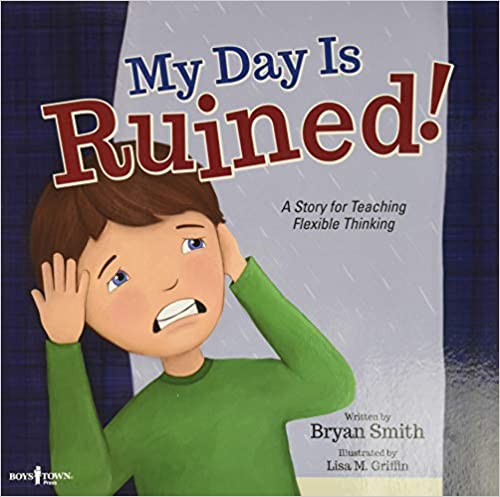Hello Everyone,
Change is difficult. It can be difficult because this change, the situation we are about to enter into, might not be going how we expected it to go. We had prepared ourselves for an experience and then that experience changed or didn’t even happen. For example, on the drive to work today I was planning on taking the highway for an early meeting. I thought to myself, that I needed to leave at a particular time to get there on time and I even imagined myself sipping my coffee and having a relaxing drive, arriving to work with lots of time for my meeting. I am sure you can see where this is going. I arrived at the on-ramp and there was a traffic jam. I was immediately flooded with feelings of frustration because how I imagined my morning would go suddenly seemed impossible.
For children, a change in routine or the expected can be especially difficult. This week I wanted to highlight a skill (Flexible Thinking) to help you and your child when unexpected change comes up.
What is Flexible Thinking?
Flexible thinking is the ability to shift thinking or attention in response to a switch in rules, or to new or unexpected situations.
Why is Flexible Thinking important?
Here is another driving analogy I borrowed from a colleague. Imagine driving without your GPS and you reach a “road closed” sign; you have no idea where you are or where to go next. You might get angry and consider taking the closed road regardless. You might panic about what to do next and call someone for help. Or you might simply sit there flummoxed. These are the feelings a child with a flexible thinking challenge may experience when asked to find another way to solve a problem or move to a new, unfamiliar situation—a combination of confusion, anger at the injustice, and panic. The specific response is very dependent on the child’s personality. It may appear, at first, like a child is being stubborn or difficult when in reality they are desperately struggling to cope with things not going as expected. They are stuck in how things should be or how we expected them to be. This is often called fixed or stuck thinking.
If you’re a flexible thinker, you consider a range of different possible consequences of your actions rather than only considering an optimistic view or only considering a pessimistic view.
Optimism vs. Pessimism
For example, if you’re thinking about switching from one job to another, you wouldn’t only consider the likely upsides or the likely downsides, you’d consider both.
If you know you tend to be too optimistic or too pessimistic, you factor this in when you’re thinking about things, as a reminder to yourself to consider the other side of the coin.
- Avoid using words that indicate only one good option or outcome. Examples include words such as never, always, won’t, or can’t. There are certainly instances when it makes sense to use these words, but it’s important to recognize that their regular inclusion in our thought processes may decrease the potential for flexible thinking.
- Be careful about placing high value on particular things, people, and situations while denying the potential value of others. Placing certain items, individuals, or outcomes on a pedestal while dismissing or minimizing the value of alternatives runs the risk of leaving you very few acceptable options. The feeling that we have no other options when something doesn’t work out can lead to hopelessness.
- Remember that our circumstances are often temporary. Attaching too much significance to specific events and thinking of outcomes as permanent can make us feel trapped. It can decrease our ability to be resilient because we either believe the best of life is behind us or we feel powerless to find ways to improve our situation. Instead, we should acknowledge our feelings while reminding ourselves that situations will change, and we can work to change them
Here Are 5 Ways To Teach, Practice and Grow Flexible Thinking
1. Be A Flexible Role Model: In order to teach flexible thinking, you need to live flexible thinking. In other words, you need to demonstrate flexible thinking in front of your students.
I’m sure you do a lot of flexible thinking during the day, the key is to not keep it a secret! Let the kids know and highlight these situations when they come up.
For example, if you are trying to present a lesson on the white board and you want a red marker, but only have black, be flexible and use the black….but TELL the kids what you are doing. This is very simple but is a great and very easy opportunity to model flexible thinking.
2. Create Opportunities: Provide lots of opportunities to practice being flexible. If you set your home or classroom up so that there is no room for change, it will be difficult for children to practice flexible thinking.
3. Reward Flexible Thinking: When you see it, reward it! A quick compliment can go a long way. You can also highlight the situation so that other children can learn from the situation.
4. Offer Alternatives Frequently: Offer alternative to how to do things, say things, or use things as often as possible. This will help children to see how to be flexible and to see the value in thinking flexibly.
5. Explicit Teaching: Play games and engage in activities that teach flexible thinking. It’s fun!
Here are some flexible thinking resources that I wanted to highlight this week:




Here is one last video of flexible thinking in action. Enjoy and have a great day.
Here’s what I think about the topic. Developing flexible thinking in kids is crucial for problem-solving and resilience. Encourage open-mindedness by exposing them to diverse experiences, cultures, and perspectives. Foster creativity with activities that have no right or wrong answers, such as art or brainstorming sessions. Teach them that it’s okay to make mistakes, as they can lead to new ideas and solutions. When faced with challenges, ask open-ended questions to stimulate their critical thinking. Encourage them to consider various options and consequences, enhancing decision-making skills. Lastly, model flexibility by adapting to change and demonstrating how to handle unexpected situations calmly and positively. This will help kids become adaptable and open to different possibilities.
Read more here https://aliciaortego.com/the-power-of-flexible-thinking/